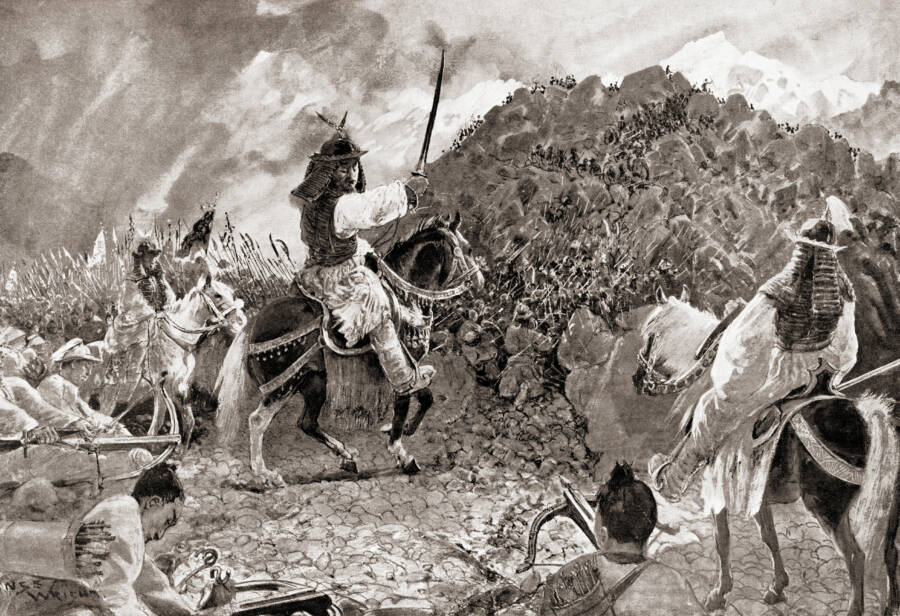“Ancient Mystery Unveiled: Gruesome Mass Grave of Dismembered Han Warriors Discovered Near Great Wall”
Imagine stumbling upon a grisly mass grave in the rugged landscapes of southern Mongolia— a burial site containing the remains of a band of warriors, each one met with a brutal end during the Han-Xiongnu Wars in the second century B.C.E. The discovery raises a haunting question: what stories did these men carry with them, and how did they end up here, victims of a violent past? Archaeologists have peeled back the layers of time, using cutting-edge DNA analysis to reveal the identities of these fallen soldiers, shedding light on a chapter of history that intertwines war, culture, and survival. In this tale of skeletons and struggle, we uncover not just who these men were, but the tragic cost of conflict in an era long gone. Curious to dive deeper into this fascinating excavation? LEARN MORE.
This grisly burial pit uncovered in southern Mongolia holds the remains of roughly two dozen warriors who were violently executed during the Han-Xiongnu Wars in the second century B.C.E.

Alexey KovalevThe Han warriors buried in this mass grave found in southern Mongolia all seem to have died in gruesomely violent ways.
More than 2,000 years ago, a terrible massacre took place on the edge of a fortress in present-day Mongolia. A group of men were butchered, then buried in a mass grave.
But until recently, archaeologists weren’t sure who controlled the fortress — or who was buried in this grisly pit. However, a new DNA analysis of the bones has finally shed light on this violent slaughter.
According to a new study, the men who were dismembered and buried in the mass grave were Han warriors who seemingly lost their lives during the Han-Xiongnu Wars in the second century B.C.E. This, in turn, lends credence to the theory that the fortress belonged to the Han, and could be the historic lost fortress known as Shouxiangcheng.
Analysis Of The Ancient Mass Grave Found In Southern Mongolia

Alexey KovalevOne of the Han warriors buried in the pit located near the Great Wall of China.
The focus of the study, recently published in the Journal of Archaeological Science, was the archaeological site of Bayanbulag in southern Mongolia, not far from the Great Wall of China. This was the site of an ancient fortress, largely believed to have been controlled by the Han. Sixteen years ago, archaeologists working at the site found a mass grave in a nearby streambank containing 20 skeletons and 33 body fragments.
Archaeologists determined that there were at least 17 people in the grave, and perhaps more than two dozen. They were all men between the ages of 20 and 50 years old, and they’d all died violent deaths, with many dismembered.
“Judging by the poses of these people, they were kneeling when they were killed, or lying [down],” study co-author Alexey Kovalev told All That’s Interesting in an email. “One was lying on his back and trying to cover himself with his hands, so his arms and legs were cut off, so he stiffened in rigor mortis. [Another’s] head was cut off and taken away as proof of victory.”

Alexey KovalevThe skeletons reveal that many of these men died grisly deaths via dismemberment.
Indeed, archaeologists suspected that the men had been butchered during one of the many clashes between the Han and the nomadic Xiongnu people that took place during this era. But were the men in the mass grave Han or Xiongnu?
Uncovering The Story Of The Slain Han Warriors And The Fortress They Protected
In order to investigate the identity of the men in the mass grave, the researchers turned to analysis of DNA and isotopes in the bones.
By studying the DNA from 14 of the skeletons, the researchers were able to determine that they resembled populations from the Yellow River Basin in China. What’s more, the isotopes in their bones — which can offer clues about where someone grew up — revealed that the men in the mass grave did not come from the Mongolian Plateau. Unlike the nomadic Xiongnu, who ate mostly meat and dairy, the dead men’s diets consisted of plants and meat.
In other words, the men in the grave were likely Han warriors. Archaeologists believe that they were a squad of Han fighters who were attacked and dismembered by Xiongnu warriors some 2,100 years ago.
This lined up with the researchers’ hypothesis about the grave. As Kovalev told All That’s Interesting: “Execution by dismemberment was the most shameful form of execution for Chinese. [So] it is very unlikely that the Chinese themselves dismembered their comrades.”
Indeed, the researchers saw signs that the Han tried to care for their fallen men. They seemingly tried to collect all the pieces of the soldiers’ bodies to bury them together, hoping, perhaps, to allay the shame of dismemberment.
“[T]hose who buried these soldiers tried to make them feel good in the afterlife,” Kovalev explained to All That’s Interesting. “It is significant that all the small pieces of severed arms and legs, severed heads and other pieces of human bodies were collected for burial. In addition, they put a halberd and a cheekpiece, symbolizing their military service (most likely in the cavalry). As for the actions of the enemies, we clearly see the atrocities of the Xiongnu.”













